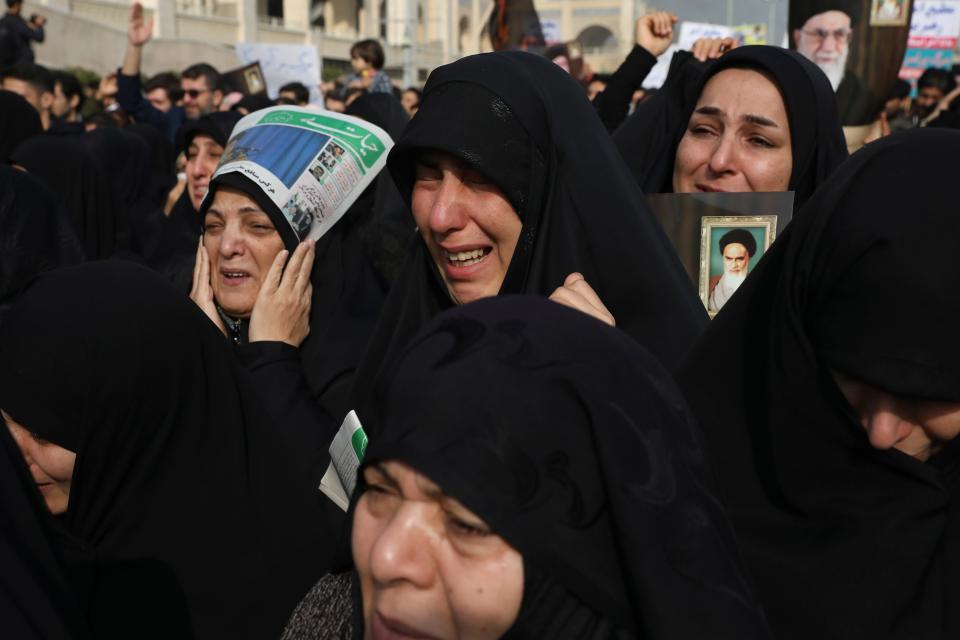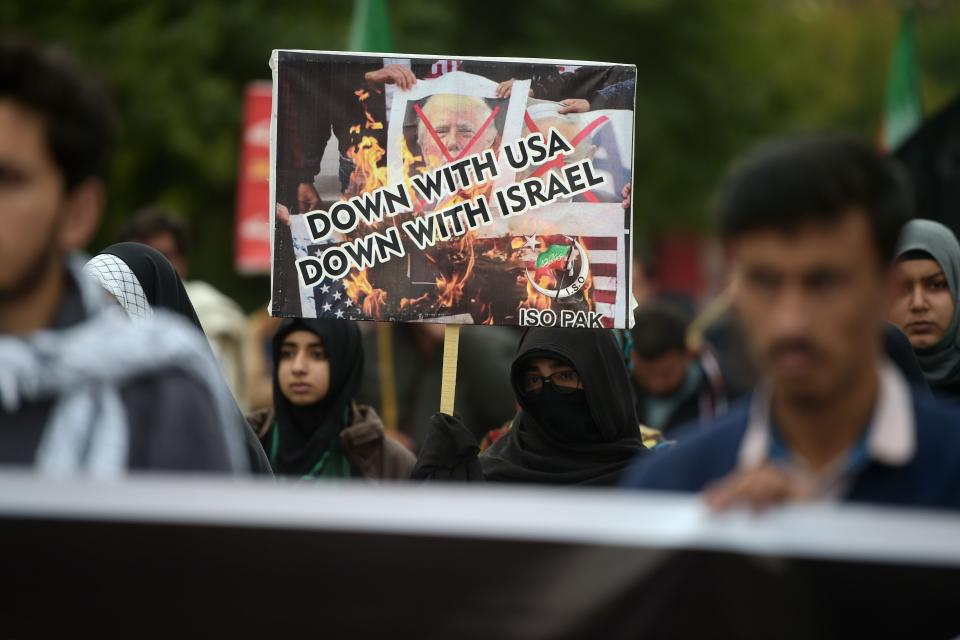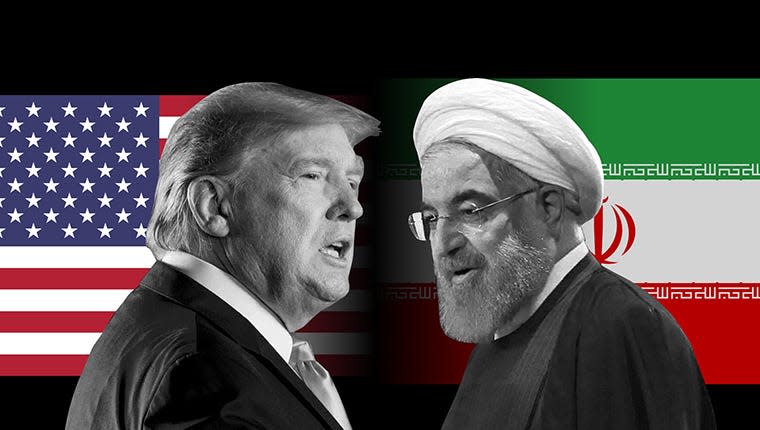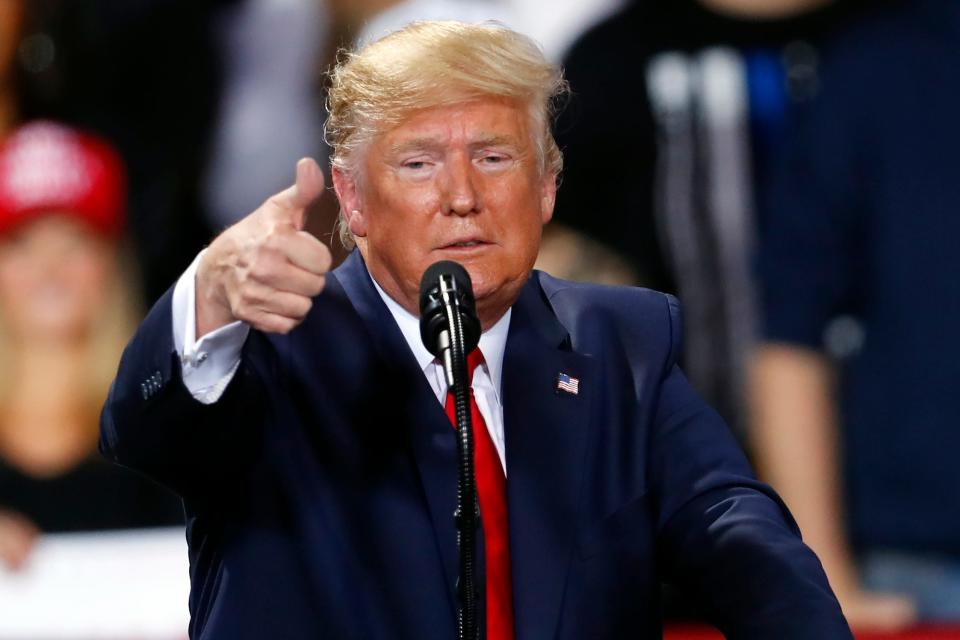'I want to have peace.' How Trump went from a vow to avoid conflict to an order to kill Iran general
WASHINGTON – President Donald Trump was a picture of calm as he strolled onto the red carpet for a New Year's Eve party at his Florida resort this week. After threatening Iran in a series of tweets hours earlier, Trump seemed eager to lower tensions.
"I want to have peace. I like peace," Trump, clad in a tuxedo, told reporters when asked if an attack on the U.S. Embassy in Baghdad would lead to war with Iran. "I don’t see that happening."
But the president's allies described a more tense picture behind the scenes as he shuttled between his Mar-a-Lago estate and meetings at his nearby golf course where he huddled with advisers to craft a response to the violent protests at the U.S. compound that reverberated around the globe.
That response, Americans would learn days later, would include a move widely seen as escalating aggression in the region rather than alleviating it: A U.S. drone strike targeting Iranian Major General Qasem Soleimani, the second most powerful leader in Iran and commander of the Quds Force of the Islamic Revolutionary Guard Corps. His death near Baghdad International Airport triggered vows of reprisal from Iran and threatened to reshape a presidency that has rested on a promise to withdraw from overseas conflicts rather than pursue them.

Thursday's airstrike, while at odds with the president's long-stated desire to pull troops out of the Middle East, was the culmination of a growing proxy battle between Iran and Washington after Trump withdrew the U.S. last year from a multilateral agreement intended to curb Tehran's nuclear weapons program. The Trump administration has since blamed Iran for attacking tankers near the Strait of Hormuz, downing a U.S. drone in June and a rocket barrage Friday that killed a U.S. defense contractor at a compound in northern Iraq.
After the strike on Soleimani, the Pentagon announced the deployment of about 3,000 more troops to the Middle East.
Trump told reporters in Florida Friday he was "ready and prepared to take whatever action is necessary" to deal with Iranian aggression. He said he had already "fully identified" potential military targets should Iran act.
If Trump's message of seeking peace appears at odds with ordering missile strikes, selecting targets and expanding the nation's military footprint, it may be explained in part by the contradictory promises he has made to his supporters, experts said.
"He’s promised the base that he’s going to pull us out of Middle East conflicts, and he’s also promised the base that he is going to push back on Iranian efforts to threaten the United States, Israel and our allies," said Thomas Warrick, a former counterterrorism official at the Department of Homeland Security and an Atlantic Council senior fellow.
"The Iranians," Warrick said, "are now going to force him to choose which of those is more important."
Photos of damage: Photos reveal extensive damage to US Embassy in Baghdad
Soleimani: Who was Iranian Gen. Qasem Soleimani?

Soleimani long a target
Soleimani has long been watched by U.S. intelligence but officials said Trump authorized the strike on him shortly after the military base attack near Kirkuk on Dec. 27 that left an American contractor dead.
The decision played out over several days as the escalation between Washington and Tehran unfolded.
“The president was kept apprised on an ongoing basis,” White House National Security Adviser Robert O’Brien told reporters.
Secretary of State Mike Pompeo, Secretary of Defense Mark Esper and Mark Milley, chairman of the Joint Chiefs of Staff, appeared at Mar-a-Lago on Sunday evening to brief reporters about the first round of airstrikes. Esper presaged the possibility of other military action in the region, noting he had discussed with Trump "other options that are available."
Trump traveled between Mar-a-Lago to nearby Trump International Golf Club, where he stayed for less than an hour rather than the several hours he has taken to golf on most days since Christmas.
Trump was then suddenly shuttled back to Mar-a-Lago. He fired off a barbed tweet complaining about criticism that he went golfing when, he said, he had actually been holding "meeting(s) in various locations, while closely monitoring the U.S. Embassy situation in Iraq." It was not clear why Trump held those meetings at the golf course rather than at Mar-a-Lago, and neither Trump nor his aides have explained it.
Among the people who joined Trump at the golf club was Sen. Lindsey Graham, R-S.C., a close ally of the president and an outspoken hawk on Iran. Graham told Fox News he had been briefed about "the potential operation" during his visit to Florida. "I appreciate being brought into the orbit," he said.
House Minority Leader Kevin McCarthy also spent time with Trump at Mar-a-Lago.
White House officials and Trump monitored the embassy attack from Florida. Images documented the extent of the damage: A burned-out reception area, broken windows and rooms that appeared to be completely destroyed.
On New Year's Eve, when Trump emerged on the red carpet to join his guests at a party, he played down the prospect of war.
"I don't think that would be a good idea for Iran. It wouldn’t last very long," Trump said. "No, I don’t think Iran would want that to happen. It would go very quickly."
U.S. intelligence had been tracking Soleimani's movements throughout the region, officials said, and the strike depended on his appearance at the airport. Otherwise, it would have been called off. Soleimani was a potential target for a long time – dating back to prior presidential administrations – and it appears the Trump administration may have began laying the legal groundwork for the strike as early as April. That’s when the State Department designated the Revolutionary Guard as a foreign terrorist organization.
"Ever since Soleimani (was) approved as a foreign terrorist, the authority to hit him has been on the table," said Kirsten Fontenrose, former Trump national security adviser who is now at the Atlantic Council. "What would have been the game changer in terms of allowing it to happen will have been the strikes on the Kirkuk base."

Deterrence vs. response
Experts say Trump set the stage for the rising U.S.-Iran tensions by fulfilling a campaign promise to abandon former President Barack Obama’s landmark nuclear deal with Tehran in May 2018. He reimposed sanctions against Tehran and its trade partners, further isolating the U.S. from European allies who were signatories to the accord and setting in motion ripple effects that led to deeper regional tensions across the Middle East.
What followed was a series of provocations, which included Trump abruptly calling off airstrikes on Iran in June 2019 after the downing of a U.S. drone. He revealed strikes had been planned for three locations but decided against the action after considering the potential death toll. But the U.S. has continued to strengthen its forces there, sending an aircraft carrier strike group and B-52 bombers to the region last year, while Pompeo and other administration officials have accused Iran of attacks in Syria and Saudi Arabia.
Trump and his top advisers have repeatedly touted their "maximum pressure" policy, a sanctions-driven campaign designed to isolate Tehran diplomatically and cripple the country economically. But increased aggression by Iran has raised questions about how effective that approach has been.
The president's tough talk on Iran has been at odds with his promise to withdraw U.S. military from the Middle East and his constant criticism of predecessors for engaging the troops in Iraq and Afghanistan. Trump faced bipartisan backlash last year for withdrawing from the Syria-Turkey border, virtually clearing the way for Turkey to invade its neighbor to the south. In a series of tweets at the time, Trump said that "fighting between various groups that has been going on for hundreds of years. USA should never have been in Middle East."
He added: "The stupid endless wars, for us, are ending!”
Precisely what caused Trump to risk getting involved in a war with Iran is not clear, but Trump said Friday that the decision to take out Soleimani was about preventing an impending attack on Americans.
Neither the White House nor the Pentagon have detailed the plot.
"He’d just come from Damascus where he was planning attacks on American soldiers, airmen, Marines, sailors and against our U.S. diplomat,” O’Brien said.
“This was us disrupting a plot that the leadership was well aware of – that Soleimani was involved with,” he said. Neither the White House nor the Pentagon have detailed what Trump said was an 'imminent" plot against Americans.
Soleimani has long been in the crosshairs of U.S. military. But both former presidents George H.W. Bush and Barack Obama ultimately decided against taking him out in fear of Iranian retaliation spiraling into war. Gen. Stanley McChrystal recalled tracking the top Iranian general to a convoy traveling from Iran into northern Iraq in 2007, making the decision to let him slip away into darkness on a January night.
“To avoid a firefight, and the contentious politics that would follow, I decided that we should monitor the caravan, not strike immediately,” he wrote in a Foreign Policy profile of the military commander last year.

Wagging the dog?
Aaron David Miller, a senior fellow with the Carnegie Endowment for International Peace, said the Iranian military leader's death may be the most consequential act in the Middle East in decades. It will likely be "perceived not just as an escalation in the US-Iran shadow war but as an act of war against regime," he said.
Some critics accused Trump of "wagging the dog," seeking to divert political attention ahead of the Senate impeachment trial. Trump's foreign policy – his interactions with both Russia and Ukraine, specifically – have been the subject of criticism for most of his presidency.
"So what if Trump wants war, knows this leads to war and needs the distraction? Real question is, will those with congressional authority step in and stop him?" Rep. Ilhan Omar, D-Minn., posted to Twitter on Friday.
In December 1998, Republicans lobbed the same accusation against President Bill Clinton, who authorized air strikes against Saddam Hussein's government in Iraq right before the House of Representatives was scheduled to vote on articles of impeachment against him. Clinton and aides rejected the charge, saying the strikes were justified by Iraq's refusal to deal with international weapons inspectors.
Trump also rejected the accusation.
"We took action last night to stop a war," Trump said Friday at Mar-a-Lago. "We did not take action to start a war."
Contributing: Deirdre Shesgreen, Christal Hayes, John Bacon

This article originally appeared on USA TODAY: Qasem Soleimani death: How Trump arrived at order to kill Iran general
